Business Environment Analysis Report: Tesco, ARCH, and Stakeholders
VerifiedAdded on 2020/02/03
|11
|2801
|93
Report
AI Summary
This report provides an analysis of the business environment, comparing and contrasting two organizations: Tesco, a for-profit grocery retailer, and Action on Rights for Children (ARCH), a non-profit organization. The report begins with an introduction outlining the objectives of the assignment, which include understanding the types of businesses, stakeholders, organizational structures, and environmental influences. Task 1 describes the business types and stakeholders of both organizations, highlighting the differences in their missions and target audiences. Task 2 examines the organizational structures of Tesco and ARCH, emphasizing the hierarchical structures and the roles of different management levels. The report further explores the influence of the economic environment on business activities, and it describes the effects of social, legal, and political factors on the operations of both organizations. The analysis considers how factors such as consumer preferences, government regulations, and economic policies impact the organizations. The report concludes by summarizing the key findings and insights gained from the analysis, emphasizing the importance of understanding the business environment for organizational success.
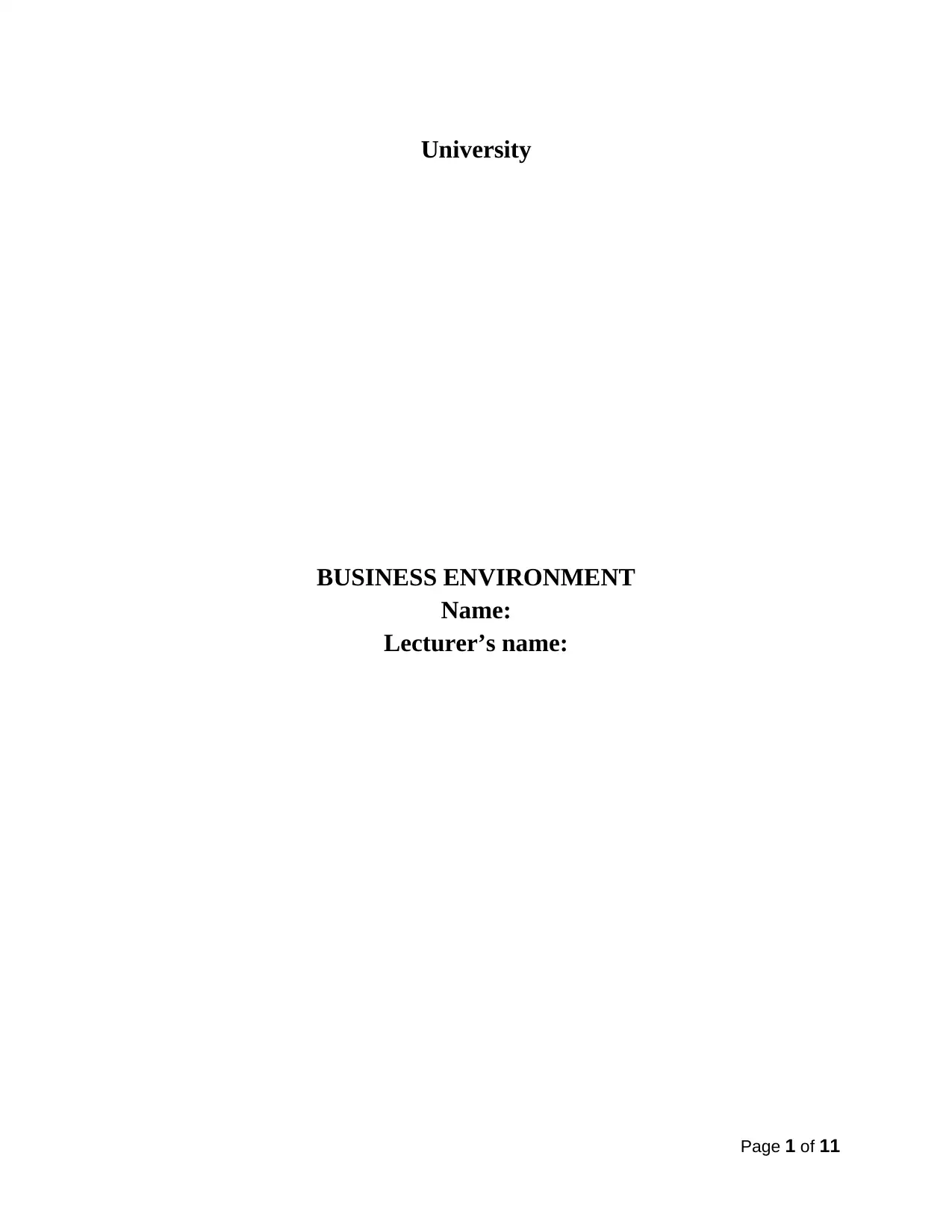
University
BUSINESS ENVIRONMENT
Name:
Lecturer’s name:
Page 1 of 11
BUSINESS ENVIRONMENT
Name:
Lecturer’s name:
Page 1 of 11
Paraphrase This Document
Need a fresh take? Get an instant paraphrase of this document with our AI Paraphraser
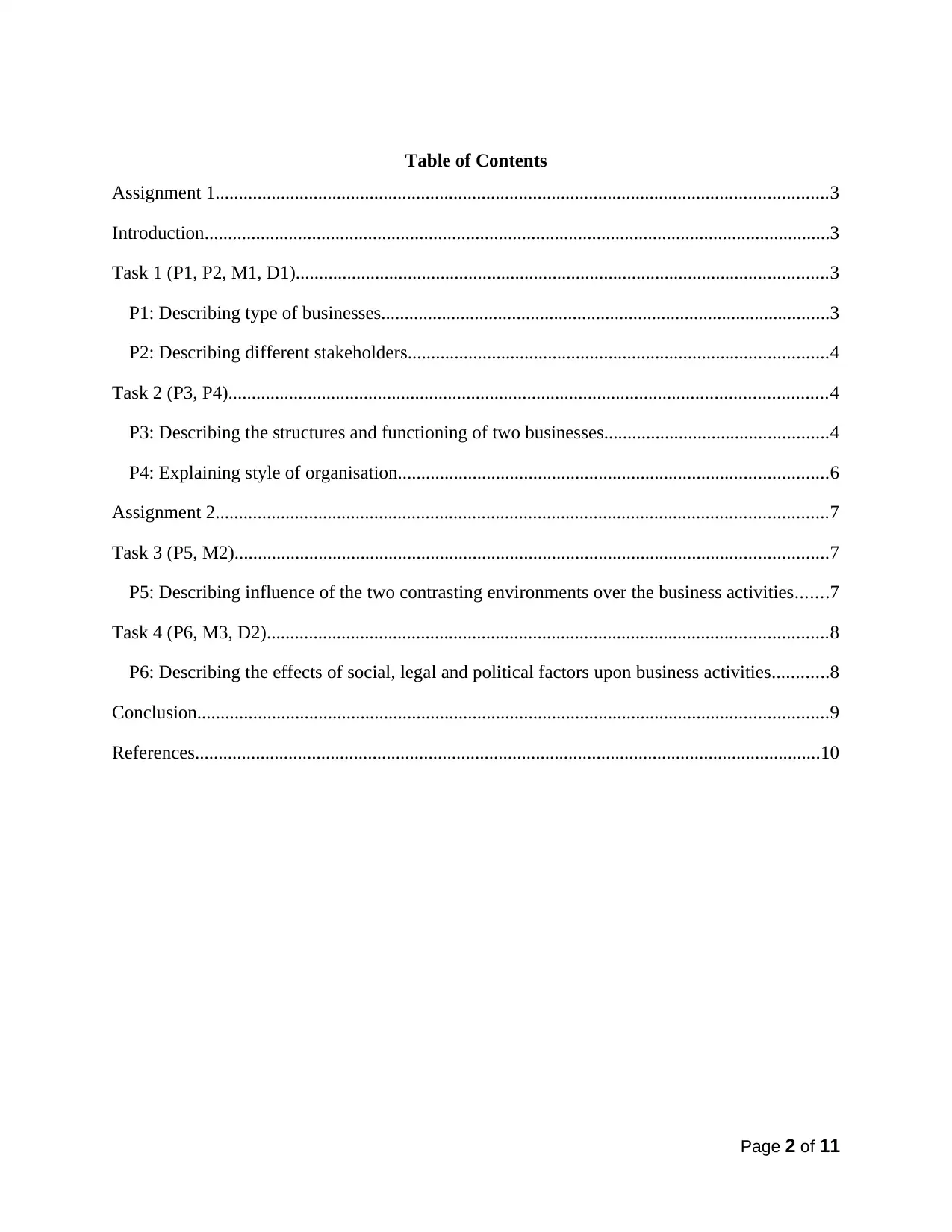
Table of Contents
Assignment 1...................................................................................................................................3
Introduction......................................................................................................................................3
Task 1 (P1, P2, M1, D1)..................................................................................................................3
P1: Describing type of businesses................................................................................................3
P2: Describing different stakeholders..........................................................................................4
Task 2 (P3, P4)................................................................................................................................4
P3: Describing the structures and functioning of two businesses................................................4
P4: Explaining style of organisation............................................................................................6
Assignment 2...................................................................................................................................7
Task 3 (P5, M2)...............................................................................................................................7
P5: Describing influence of the two contrasting environments over the business activities.......7
Task 4 (P6, M3, D2)........................................................................................................................8
P6: Describing the effects of social, legal and political factors upon business activities............8
Conclusion.......................................................................................................................................9
References......................................................................................................................................10
Page 2 of 11
Assignment 1...................................................................................................................................3
Introduction......................................................................................................................................3
Task 1 (P1, P2, M1, D1)..................................................................................................................3
P1: Describing type of businesses................................................................................................3
P2: Describing different stakeholders..........................................................................................4
Task 2 (P3, P4)................................................................................................................................4
P3: Describing the structures and functioning of two businesses................................................4
P4: Explaining style of organisation............................................................................................6
Assignment 2...................................................................................................................................7
Task 3 (P5, M2)...............................................................................................................................7
P5: Describing influence of the two contrasting environments over the business activities.......7
Task 4 (P6, M3, D2)........................................................................................................................8
P6: Describing the effects of social, legal and political factors upon business activities............8
Conclusion.......................................................................................................................................9
References......................................................................................................................................10
Page 2 of 11
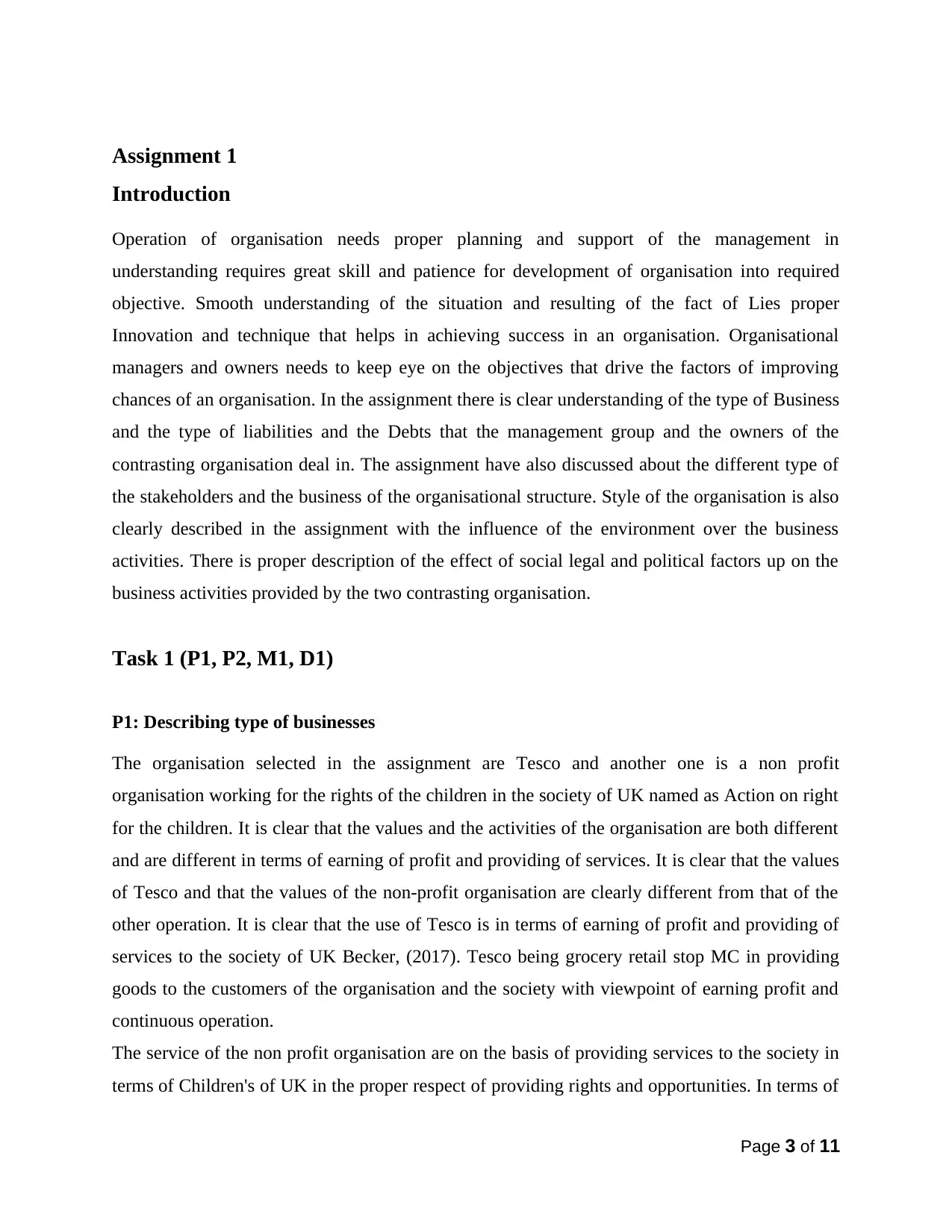
Assignment 1
Introduction
Operation of organisation needs proper planning and support of the management in
understanding requires great skill and patience for development of organisation into required
objective. Smooth understanding of the situation and resulting of the fact of Lies proper
Innovation and technique that helps in achieving success in an organisation. Organisational
managers and owners needs to keep eye on the objectives that drive the factors of improving
chances of an organisation. In the assignment there is clear understanding of the type of Business
and the type of liabilities and the Debts that the management group and the owners of the
contrasting organisation deal in. The assignment have also discussed about the different type of
the stakeholders and the business of the organisational structure. Style of the organisation is also
clearly described in the assignment with the influence of the environment over the business
activities. There is proper description of the effect of social legal and political factors up on the
business activities provided by the two contrasting organisation.
Task 1 (P1, P2, M1, D1)
P1: Describing type of businesses
The organisation selected in the assignment are Tesco and another one is a non profit
organisation working for the rights of the children in the society of UK named as Action on right
for the children. It is clear that the values and the activities of the organisation are both different
and are different in terms of earning of profit and providing of services. It is clear that the values
of Tesco and that the values of the non-profit organisation are clearly different from that of the
other operation. It is clear that the use of Tesco is in terms of earning of profit and providing of
services to the society of UK Becker, (2017). Tesco being grocery retail stop MC in providing
goods to the customers of the organisation and the society with viewpoint of earning profit and
continuous operation.
The service of the non profit organisation are on the basis of providing services to the society in
terms of Children's of UK in the proper respect of providing rights and opportunities. In terms of
Page 3 of 11
Introduction
Operation of organisation needs proper planning and support of the management in
understanding requires great skill and patience for development of organisation into required
objective. Smooth understanding of the situation and resulting of the fact of Lies proper
Innovation and technique that helps in achieving success in an organisation. Organisational
managers and owners needs to keep eye on the objectives that drive the factors of improving
chances of an organisation. In the assignment there is clear understanding of the type of Business
and the type of liabilities and the Debts that the management group and the owners of the
contrasting organisation deal in. The assignment have also discussed about the different type of
the stakeholders and the business of the organisational structure. Style of the organisation is also
clearly described in the assignment with the influence of the environment over the business
activities. There is proper description of the effect of social legal and political factors up on the
business activities provided by the two contrasting organisation.
Task 1 (P1, P2, M1, D1)
P1: Describing type of businesses
The organisation selected in the assignment are Tesco and another one is a non profit
organisation working for the rights of the children in the society of UK named as Action on right
for the children. It is clear that the values and the activities of the organisation are both different
and are different in terms of earning of profit and providing of services. It is clear that the values
of Tesco and that the values of the non-profit organisation are clearly different from that of the
other operation. It is clear that the use of Tesco is in terms of earning of profit and providing of
services to the society of UK Becker, (2017). Tesco being grocery retail stop MC in providing
goods to the customers of the organisation and the society with viewpoint of earning profit and
continuous operation.
The service of the non profit organisation are on the basis of providing services to the society in
terms of Children's of UK in the proper respect of providing rights and opportunities. In terms of
Page 3 of 11
⊘ This is a preview!⊘
Do you want full access?
Subscribe today to unlock all pages.

Trusted by 1+ million students worldwide
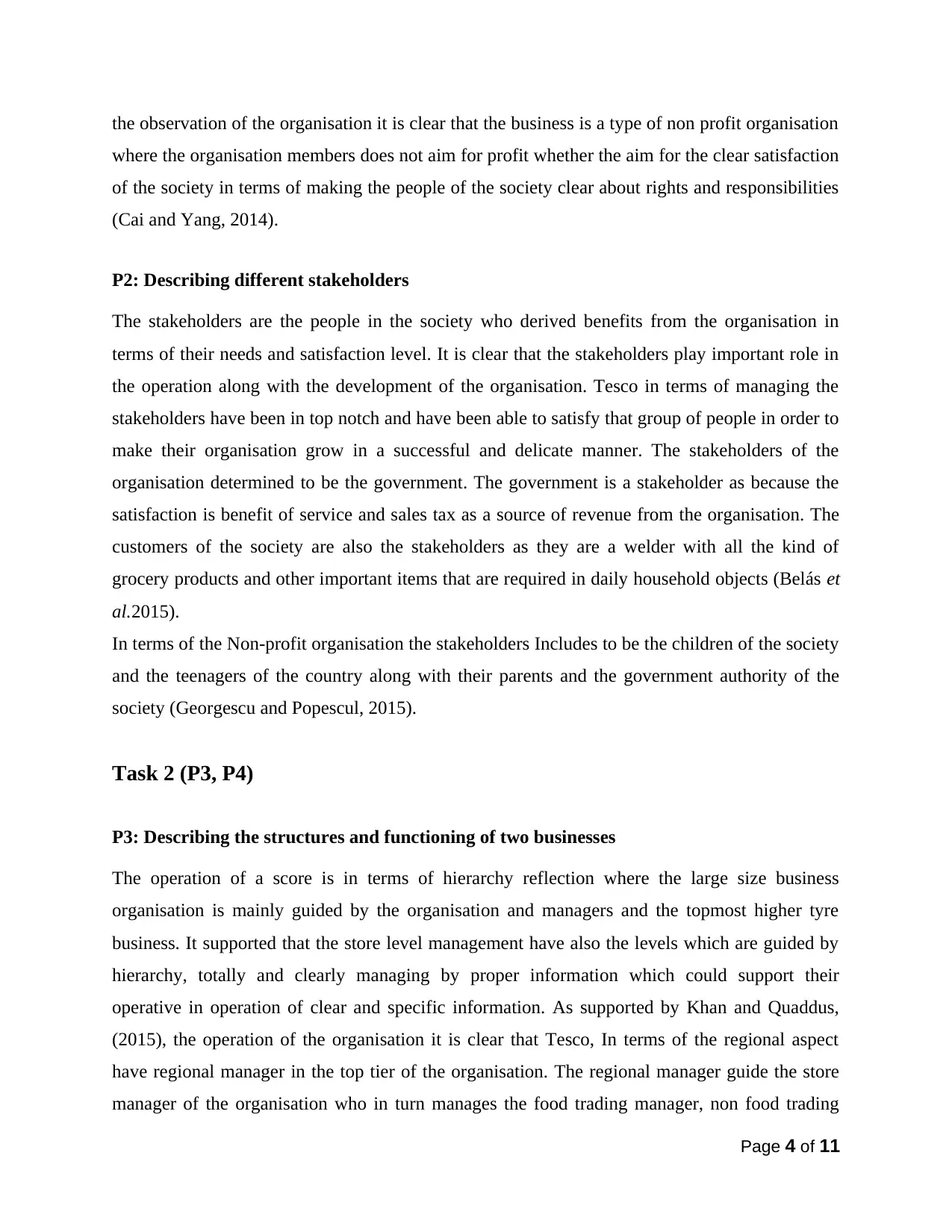
the observation of the organisation it is clear that the business is a type of non profit organisation
where the organisation members does not aim for profit whether the aim for the clear satisfaction
of the society in terms of making the people of the society clear about rights and responsibilities
(Cai and Yang, 2014).
P2: Describing different stakeholders
The stakeholders are the people in the society who derived benefits from the organisation in
terms of their needs and satisfaction level. It is clear that the stakeholders play important role in
the operation along with the development of the organisation. Tesco in terms of managing the
stakeholders have been in top notch and have been able to satisfy that group of people in order to
make their organisation grow in a successful and delicate manner. The stakeholders of the
organisation determined to be the government. The government is a stakeholder as because the
satisfaction is benefit of service and sales tax as a source of revenue from the organisation. The
customers of the society are also the stakeholders as they are a welder with all the kind of
grocery products and other important items that are required in daily household objects (Belás et
al.2015).
In terms of the Non-profit organisation the stakeholders Includes to be the children of the society
and the teenagers of the country along with their parents and the government authority of the
society (Georgescu and Popescul, 2015).
Task 2 (P3, P4)
P3: Describing the structures and functioning of two businesses
The operation of a score is in terms of hierarchy reflection where the large size business
organisation is mainly guided by the organisation and managers and the topmost higher tyre
business. It supported that the store level management have also the levels which are guided by
hierarchy, totally and clearly managing by proper information which could support their
operative in operation of clear and specific information. As supported by Khan and Quaddus,
(2015), the operation of the organisation it is clear that Tesco, In terms of the regional aspect
have regional manager in the top tier of the organisation. The regional manager guide the store
manager of the organisation who in turn manages the food trading manager, non food trading
Page 4 of 11
where the organisation members does not aim for profit whether the aim for the clear satisfaction
of the society in terms of making the people of the society clear about rights and responsibilities
(Cai and Yang, 2014).
P2: Describing different stakeholders
The stakeholders are the people in the society who derived benefits from the organisation in
terms of their needs and satisfaction level. It is clear that the stakeholders play important role in
the operation along with the development of the organisation. Tesco in terms of managing the
stakeholders have been in top notch and have been able to satisfy that group of people in order to
make their organisation grow in a successful and delicate manner. The stakeholders of the
organisation determined to be the government. The government is a stakeholder as because the
satisfaction is benefit of service and sales tax as a source of revenue from the organisation. The
customers of the society are also the stakeholders as they are a welder with all the kind of
grocery products and other important items that are required in daily household objects (Belás et
al.2015).
In terms of the Non-profit organisation the stakeholders Includes to be the children of the society
and the teenagers of the country along with their parents and the government authority of the
society (Georgescu and Popescul, 2015).
Task 2 (P3, P4)
P3: Describing the structures and functioning of two businesses
The operation of a score is in terms of hierarchy reflection where the large size business
organisation is mainly guided by the organisation and managers and the topmost higher tyre
business. It supported that the store level management have also the levels which are guided by
hierarchy, totally and clearly managing by proper information which could support their
operative in operation of clear and specific information. As supported by Khan and Quaddus,
(2015), the operation of the organisation it is clear that Tesco, In terms of the regional aspect
have regional manager in the top tier of the organisation. The regional manager guide the store
manager of the organisation who in turn manages the food trading manager, non food trading
Page 4 of 11
Paraphrase This Document
Need a fresh take? Get an instant paraphrase of this document with our AI Paraphraser
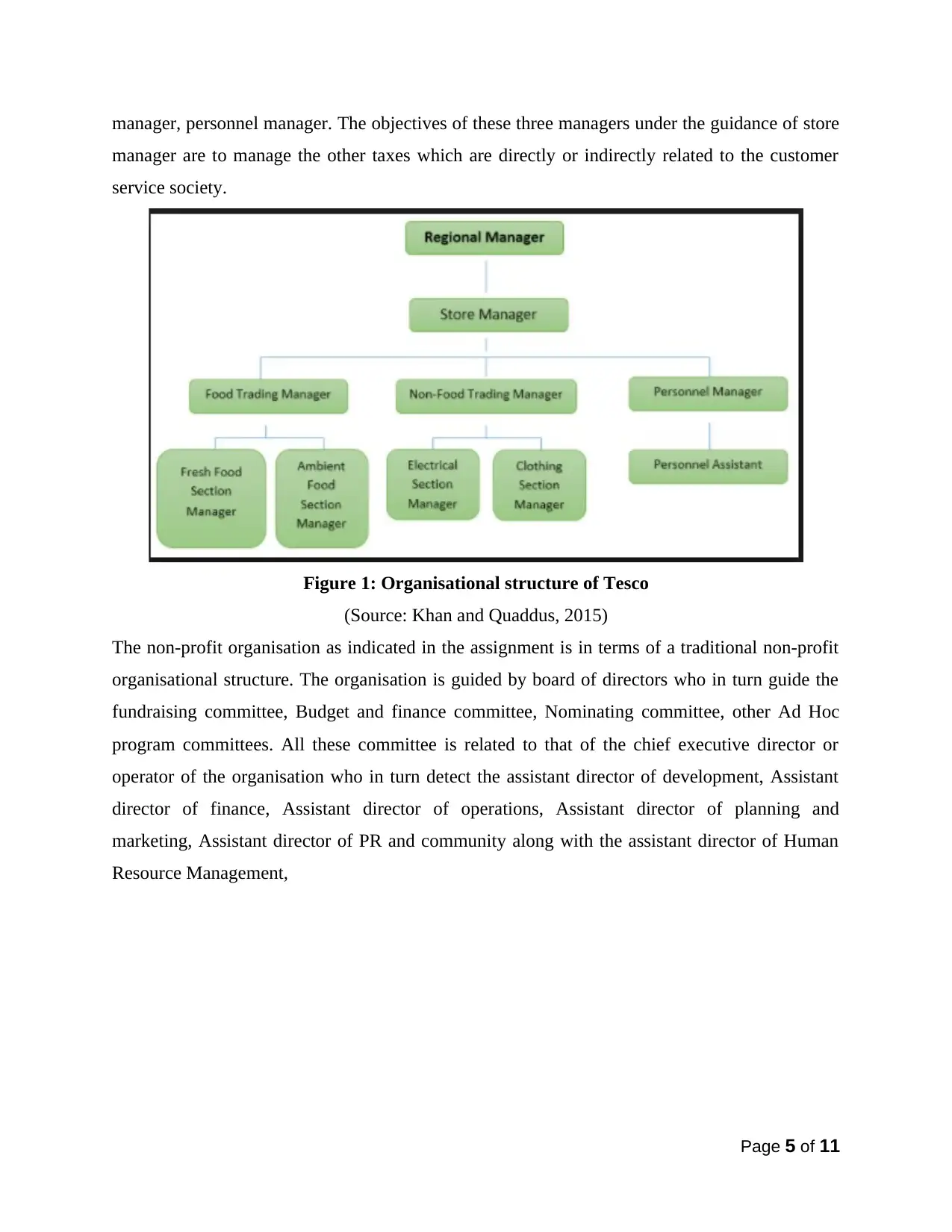
manager, personnel manager. The objectives of these three managers under the guidance of store
manager are to manage the other taxes which are directly or indirectly related to the customer
service society.
Figure 1: Organisational structure of Tesco
(Source: Khan and Quaddus, 2015)
The non-profit organisation as indicated in the assignment is in terms of a traditional non-profit
organisational structure. The organisation is guided by board of directors who in turn guide the
fundraising committee, Budget and finance committee, Nominating committee, other Ad Hoc
program committees. All these committee is related to that of the chief executive director or
operator of the organisation who in turn detect the assistant director of development, Assistant
director of finance, Assistant director of operations, Assistant director of planning and
marketing, Assistant director of PR and community along with the assistant director of Human
Resource Management,
Page 5 of 11
manager are to manage the other taxes which are directly or indirectly related to the customer
service society.
Figure 1: Organisational structure of Tesco
(Source: Khan and Quaddus, 2015)
The non-profit organisation as indicated in the assignment is in terms of a traditional non-profit
organisational structure. The organisation is guided by board of directors who in turn guide the
fundraising committee, Budget and finance committee, Nominating committee, other Ad Hoc
program committees. All these committee is related to that of the chief executive director or
operator of the organisation who in turn detect the assistant director of development, Assistant
director of finance, Assistant director of operations, Assistant director of planning and
marketing, Assistant director of PR and community along with the assistant director of Human
Resource Management,
Page 5 of 11
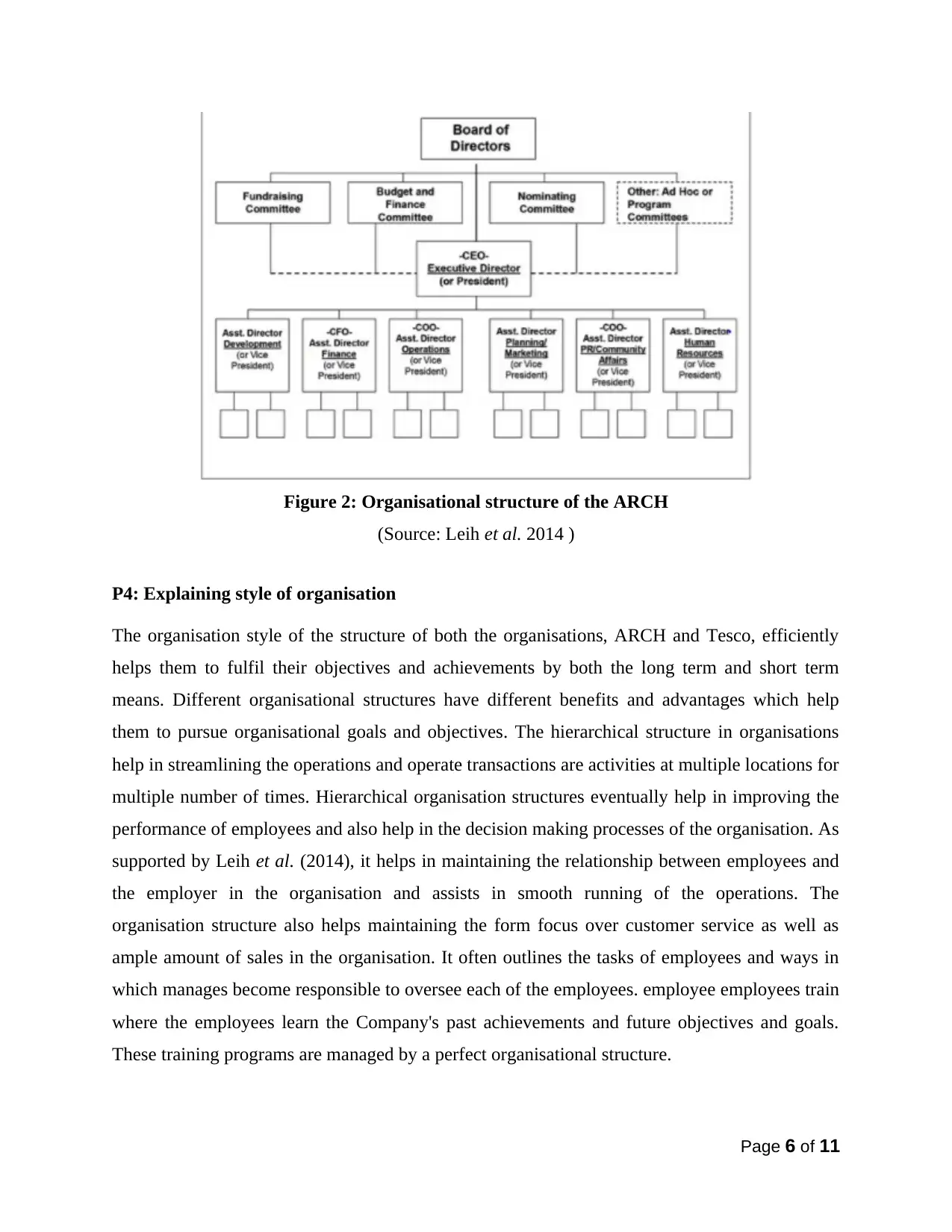
Figure 2: Organisational structure of the ARCH
(Source: Leih et al. 2014 )
P4: Explaining style of organisation
The organisation style of the structure of both the organisations, ARCH and Tesco, efficiently
helps them to fulfil their objectives and achievements by both the long term and short term
means. Different organisational structures have different benefits and advantages which help
them to pursue organisational goals and objectives. The hierarchical structure in organisations
help in streamlining the operations and operate transactions are activities at multiple locations for
multiple number of times. Hierarchical organisation structures eventually help in improving the
performance of employees and also help in the decision making processes of the organisation. As
supported by Leih et al. (2014), it helps in maintaining the relationship between employees and
the employer in the organisation and assists in smooth running of the operations. The
organisation structure also helps maintaining the form focus over customer service as well as
ample amount of sales in the organisation. It often outlines the tasks of employees and ways in
which manages become responsible to oversee each of the employees. employee employees train
where the employees learn the Company's past achievements and future objectives and goals.
These training programs are managed by a perfect organisational structure.
Page 6 of 11
(Source: Leih et al. 2014 )
P4: Explaining style of organisation
The organisation style of the structure of both the organisations, ARCH and Tesco, efficiently
helps them to fulfil their objectives and achievements by both the long term and short term
means. Different organisational structures have different benefits and advantages which help
them to pursue organisational goals and objectives. The hierarchical structure in organisations
help in streamlining the operations and operate transactions are activities at multiple locations for
multiple number of times. Hierarchical organisation structures eventually help in improving the
performance of employees and also help in the decision making processes of the organisation. As
supported by Leih et al. (2014), it helps in maintaining the relationship between employees and
the employer in the organisation and assists in smooth running of the operations. The
organisation structure also helps maintaining the form focus over customer service as well as
ample amount of sales in the organisation. It often outlines the tasks of employees and ways in
which manages become responsible to oversee each of the employees. employee employees train
where the employees learn the Company's past achievements and future objectives and goals.
These training programs are managed by a perfect organisational structure.
Page 6 of 11
⊘ This is a preview!⊘
Do you want full access?
Subscribe today to unlock all pages.

Trusted by 1+ million students worldwide
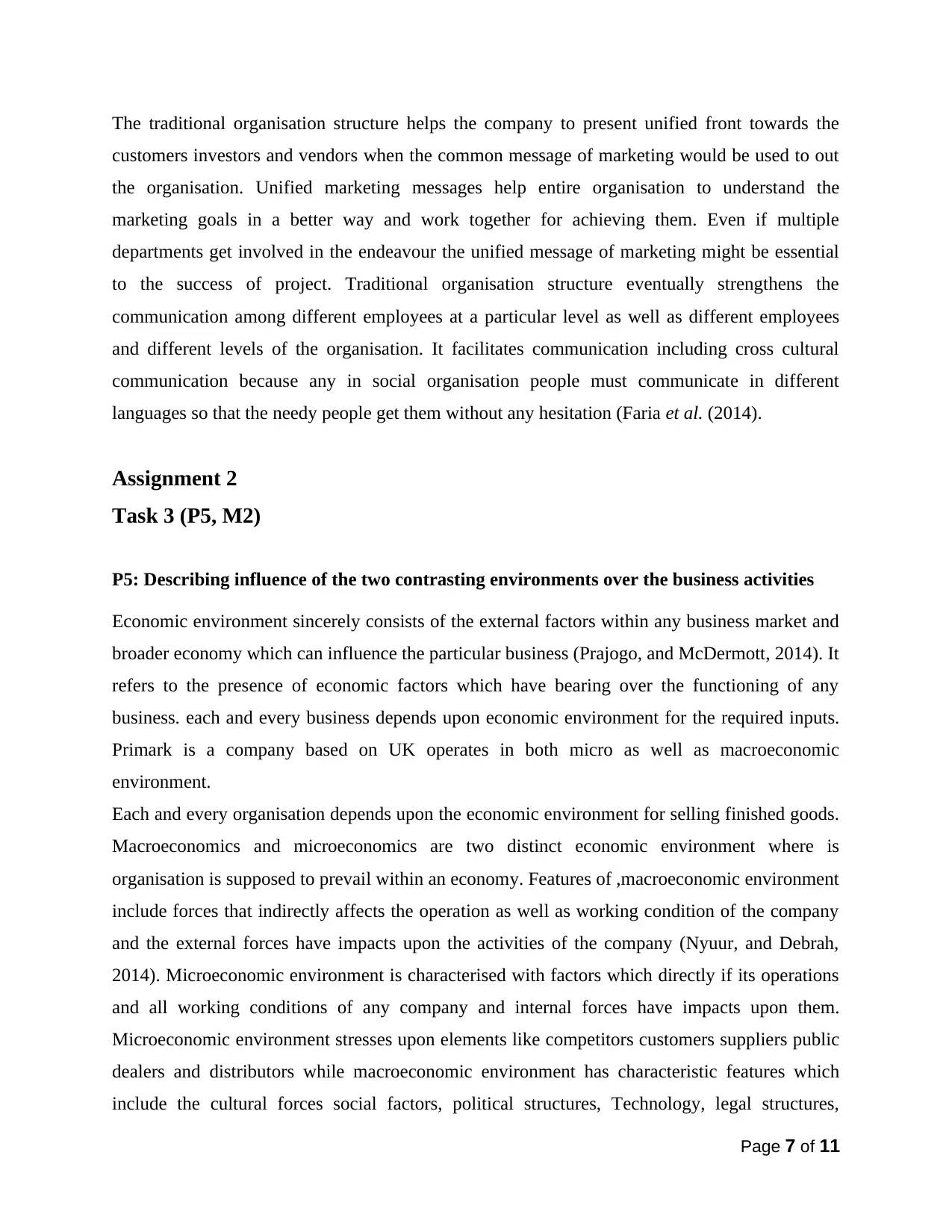
The traditional organisation structure helps the company to present unified front towards the
customers investors and vendors when the common message of marketing would be used to out
the organisation. Unified marketing messages help entire organisation to understand the
marketing goals in a better way and work together for achieving them. Even if multiple
departments get involved in the endeavour the unified message of marketing might be essential
to the success of project. Traditional organisation structure eventually strengthens the
communication among different employees at a particular level as well as different employees
and different levels of the organisation. It facilitates communication including cross cultural
communication because any in social organisation people must communicate in different
languages so that the needy people get them without any hesitation (Faria et al. (2014).
Assignment 2
Task 3 (P5, M2)
P5: Describing influence of the two contrasting environments over the business activities
Economic environment sincerely consists of the external factors within any business market and
broader economy which can influence the particular business (Prajogo, and McDermott, 2014). It
refers to the presence of economic factors which have bearing over the functioning of any
business. each and every business depends upon economic environment for the required inputs.
Primark is a company based on UK operates in both micro as well as macroeconomic
environment.
Each and every organisation depends upon the economic environment for selling finished goods.
Macroeconomics and microeconomics are two distinct economic environment where is
organisation is supposed to prevail within an economy. Features of ,macroeconomic environment
include forces that indirectly affects the operation as well as working condition of the company
and the external forces have impacts upon the activities of the company (Nyuur, and Debrah,
2014). Microeconomic environment is characterised with factors which directly if its operations
and all working conditions of any company and internal forces have impacts upon them.
Microeconomic environment stresses upon elements like competitors customers suppliers public
dealers and distributors while macroeconomic environment has characteristic features which
include the cultural forces social factors, political structures, Technology, legal structures,
Page 7 of 11
customers investors and vendors when the common message of marketing would be used to out
the organisation. Unified marketing messages help entire organisation to understand the
marketing goals in a better way and work together for achieving them. Even if multiple
departments get involved in the endeavour the unified message of marketing might be essential
to the success of project. Traditional organisation structure eventually strengthens the
communication among different employees at a particular level as well as different employees
and different levels of the organisation. It facilitates communication including cross cultural
communication because any in social organisation people must communicate in different
languages so that the needy people get them without any hesitation (Faria et al. (2014).
Assignment 2
Task 3 (P5, M2)
P5: Describing influence of the two contrasting environments over the business activities
Economic environment sincerely consists of the external factors within any business market and
broader economy which can influence the particular business (Prajogo, and McDermott, 2014). It
refers to the presence of economic factors which have bearing over the functioning of any
business. each and every business depends upon economic environment for the required inputs.
Primark is a company based on UK operates in both micro as well as macroeconomic
environment.
Each and every organisation depends upon the economic environment for selling finished goods.
Macroeconomics and microeconomics are two distinct economic environment where is
organisation is supposed to prevail within an economy. Features of ,macroeconomic environment
include forces that indirectly affects the operation as well as working condition of the company
and the external forces have impacts upon the activities of the company (Nyuur, and Debrah,
2014). Microeconomic environment is characterised with factors which directly if its operations
and all working conditions of any company and internal forces have impacts upon them.
Microeconomic environment stresses upon elements like competitors customers suppliers public
dealers and distributors while macroeconomic environment has characteristic features which
include the cultural forces social factors, political structures, Technology, legal structures,
Page 7 of 11
Paraphrase This Document
Need a fresh take? Get an instant paraphrase of this document with our AI Paraphraser
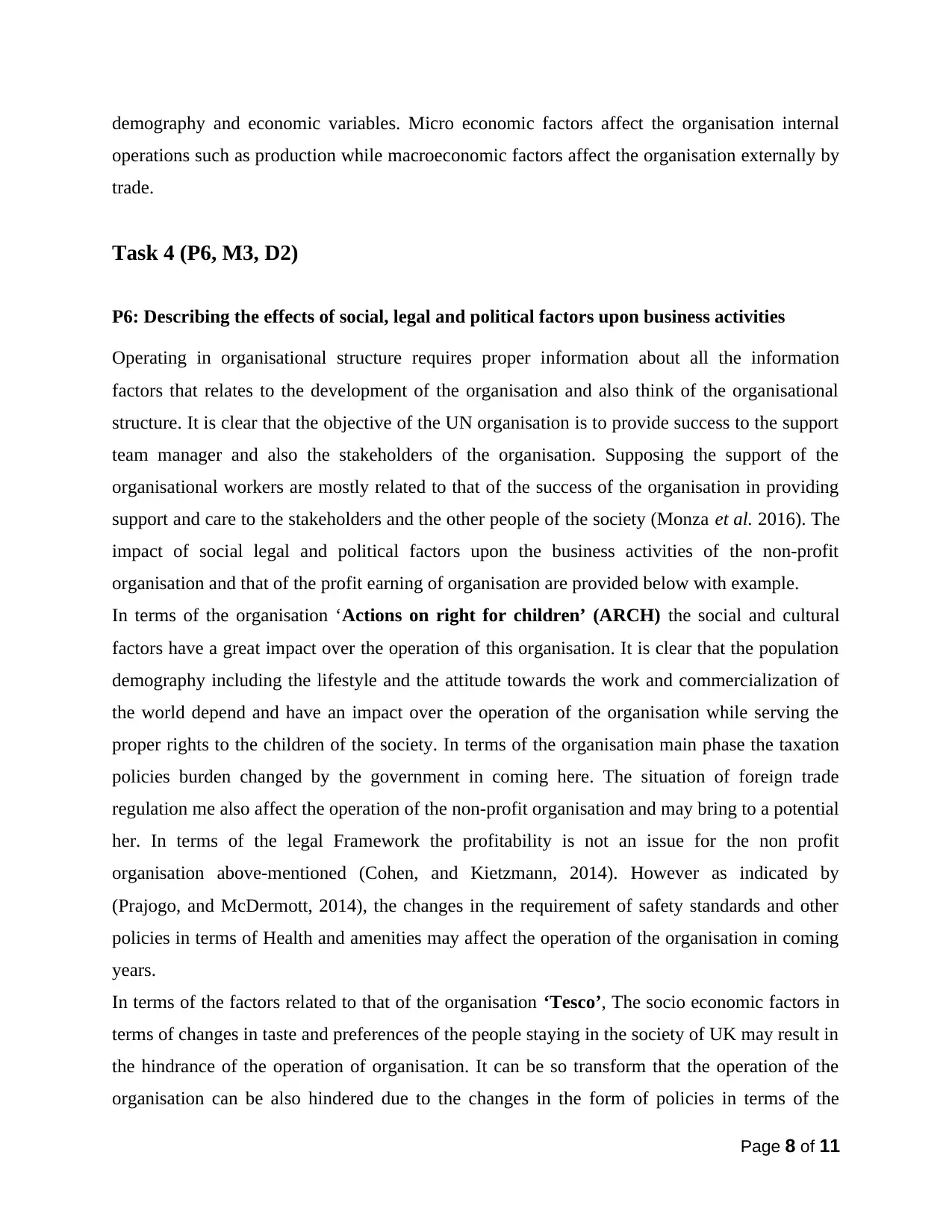
demography and economic variables. Micro economic factors affect the organisation internal
operations such as production while macroeconomic factors affect the organisation externally by
trade.
Task 4 (P6, M3, D2)
P6: Describing the effects of social, legal and political factors upon business activities
Operating in organisational structure requires proper information about all the information
factors that relates to the development of the organisation and also think of the organisational
structure. It is clear that the objective of the UN organisation is to provide success to the support
team manager and also the stakeholders of the organisation. Supposing the support of the
organisational workers are mostly related to that of the success of the organisation in providing
support and care to the stakeholders and the other people of the society (Monza et al. 2016). The
impact of social legal and political factors upon the business activities of the non-profit
organisation and that of the profit earning of organisation are provided below with example.
In terms of the organisation ‘Actions on right for children’ (ARCH) the social and cultural
factors have a great impact over the operation of this organisation. It is clear that the population
demography including the lifestyle and the attitude towards the work and commercialization of
the world depend and have an impact over the operation of the organisation while serving the
proper rights to the children of the society. In terms of the organisation main phase the taxation
policies burden changed by the government in coming here. The situation of foreign trade
regulation me also affect the operation of the non-profit organisation and may bring to a potential
her. In terms of the legal Framework the profitability is not an issue for the non profit
organisation above-mentioned (Cohen, and Kietzmann, 2014). However as indicated by
(Prajogo, and McDermott, 2014), the changes in the requirement of safety standards and other
policies in terms of Health and amenities may affect the operation of the organisation in coming
years.
In terms of the factors related to that of the organisation ‘Tesco’, The socio economic factors in
terms of changes in taste and preferences of the people staying in the society of UK may result in
the hindrance of the operation of organisation. It can be so transform that the operation of the
organisation can be also hindered due to the changes in the form of policies in terms of the
Page 8 of 11
operations such as production while macroeconomic factors affect the organisation externally by
trade.
Task 4 (P6, M3, D2)
P6: Describing the effects of social, legal and political factors upon business activities
Operating in organisational structure requires proper information about all the information
factors that relates to the development of the organisation and also think of the organisational
structure. It is clear that the objective of the UN organisation is to provide success to the support
team manager and also the stakeholders of the organisation. Supposing the support of the
organisational workers are mostly related to that of the success of the organisation in providing
support and care to the stakeholders and the other people of the society (Monza et al. 2016). The
impact of social legal and political factors upon the business activities of the non-profit
organisation and that of the profit earning of organisation are provided below with example.
In terms of the organisation ‘Actions on right for children’ (ARCH) the social and cultural
factors have a great impact over the operation of this organisation. It is clear that the population
demography including the lifestyle and the attitude towards the work and commercialization of
the world depend and have an impact over the operation of the organisation while serving the
proper rights to the children of the society. In terms of the organisation main phase the taxation
policies burden changed by the government in coming here. The situation of foreign trade
regulation me also affect the operation of the non-profit organisation and may bring to a potential
her. In terms of the legal Framework the profitability is not an issue for the non profit
organisation above-mentioned (Cohen, and Kietzmann, 2014). However as indicated by
(Prajogo, and McDermott, 2014), the changes in the requirement of safety standards and other
policies in terms of Health and amenities may affect the operation of the organisation in coming
years.
In terms of the factors related to that of the organisation ‘Tesco’, The socio economic factors in
terms of changes in taste and preferences of the people staying in the society of UK may result in
the hindrance of the operation of organisation. It can be so transform that the operation of the
organisation can be also hindered due to the changes in the form of policies in terms of the
Page 8 of 11
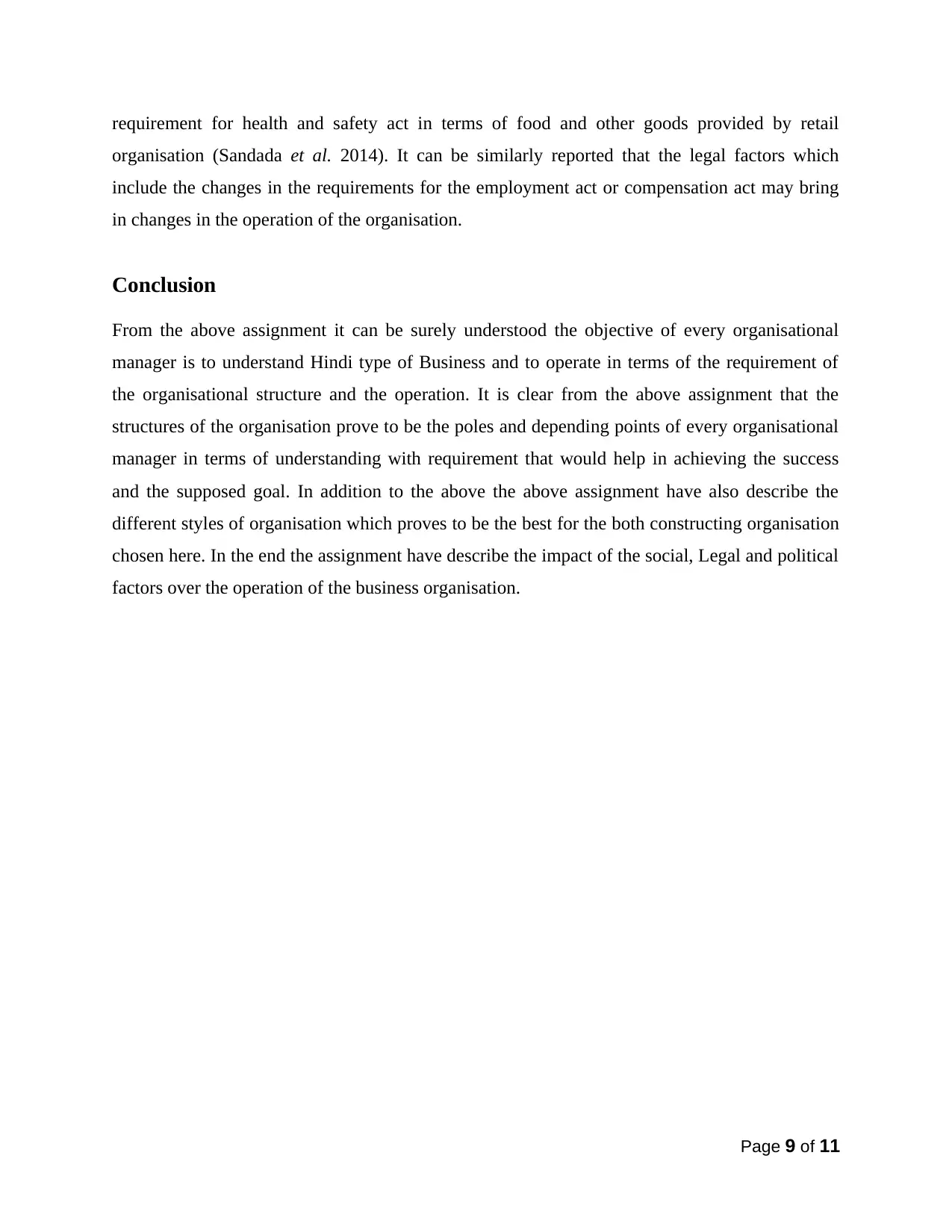
requirement for health and safety act in terms of food and other goods provided by retail
organisation (Sandada et al. 2014). It can be similarly reported that the legal factors which
include the changes in the requirements for the employment act or compensation act may bring
in changes in the operation of the organisation.
Conclusion
From the above assignment it can be surely understood the objective of every organisational
manager is to understand Hindi type of Business and to operate in terms of the requirement of
the organisational structure and the operation. It is clear from the above assignment that the
structures of the organisation prove to be the poles and depending points of every organisational
manager in terms of understanding with requirement that would help in achieving the success
and the supposed goal. In addition to the above the above assignment have also describe the
different styles of organisation which proves to be the best for the both constructing organisation
chosen here. In the end the assignment have describe the impact of the social, Legal and political
factors over the operation of the business organisation.
Page 9 of 11
organisation (Sandada et al. 2014). It can be similarly reported that the legal factors which
include the changes in the requirements for the employment act or compensation act may bring
in changes in the operation of the organisation.
Conclusion
From the above assignment it can be surely understood the objective of every organisational
manager is to understand Hindi type of Business and to operate in terms of the requirement of
the organisational structure and the operation. It is clear from the above assignment that the
structures of the organisation prove to be the poles and depending points of every organisational
manager in terms of understanding with requirement that would help in achieving the success
and the supposed goal. In addition to the above the above assignment have also describe the
different styles of organisation which proves to be the best for the both constructing organisation
chosen here. In the end the assignment have describe the impact of the social, Legal and political
factors over the operation of the business organisation.
Page 9 of 11
⊘ This is a preview!⊘
Do you want full access?
Subscribe today to unlock all pages.

Trusted by 1+ million students worldwide
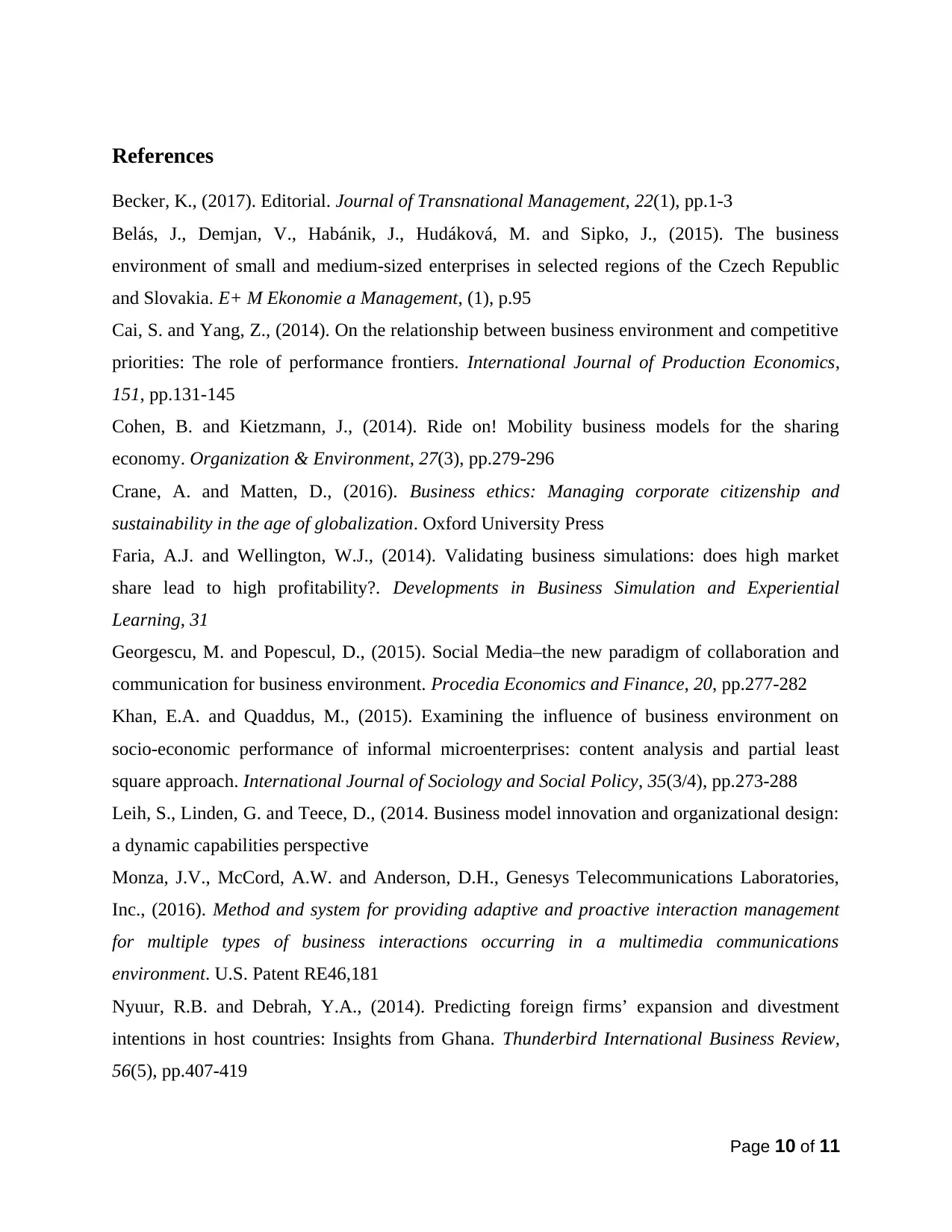
References
Becker, K., (2017). Editorial. Journal of Transnational Management, 22(1), pp.1-3
Belás, J., Demjan, V., Habánik, J., Hudáková, M. and Sipko, J., (2015). The business
environment of small and medium-sized enterprises in selected regions of the Czech Republic
and Slovakia. E+ M Ekonomie a Management, (1), p.95
Cai, S. and Yang, Z., (2014). On the relationship between business environment and competitive
priorities: The role of performance frontiers. International Journal of Production Economics,
151, pp.131-145
Cohen, B. and Kietzmann, J., (2014). Ride on! Mobility business models for the sharing
economy. Organization & Environment, 27(3), pp.279-296
Crane, A. and Matten, D., (2016). Business ethics: Managing corporate citizenship and
sustainability in the age of globalization. Oxford University Press
Faria, A.J. and Wellington, W.J., (2014). Validating business simulations: does high market
share lead to high profitability?. Developments in Business Simulation and Experiential
Learning, 31
Georgescu, M. and Popescul, D., (2015). Social Media–the new paradigm of collaboration and
communication for business environment. Procedia Economics and Finance, 20, pp.277-282
Khan, E.A. and Quaddus, M., (2015). Examining the influence of business environment on
socio-economic performance of informal microenterprises: content analysis and partial least
square approach. International Journal of Sociology and Social Policy, 35(3/4), pp.273-288
Leih, S., Linden, G. and Teece, D., (2014. Business model innovation and organizational design:
a dynamic capabilities perspective
Monza, J.V., McCord, A.W. and Anderson, D.H., Genesys Telecommunications Laboratories,
Inc., (2016). Method and system for providing adaptive and proactive interaction management
for multiple types of business interactions occurring in a multimedia communications
environment. U.S. Patent RE46,181
Nyuur, R.B. and Debrah, Y.A., (2014). Predicting foreign firms’ expansion and divestment
intentions in host countries: Insights from Ghana. Thunderbird International Business Review,
56(5), pp.407-419
Page 10 of 11
Becker, K., (2017). Editorial. Journal of Transnational Management, 22(1), pp.1-3
Belás, J., Demjan, V., Habánik, J., Hudáková, M. and Sipko, J., (2015). The business
environment of small and medium-sized enterprises in selected regions of the Czech Republic
and Slovakia. E+ M Ekonomie a Management, (1), p.95
Cai, S. and Yang, Z., (2014). On the relationship between business environment and competitive
priorities: The role of performance frontiers. International Journal of Production Economics,
151, pp.131-145
Cohen, B. and Kietzmann, J., (2014). Ride on! Mobility business models for the sharing
economy. Organization & Environment, 27(3), pp.279-296
Crane, A. and Matten, D., (2016). Business ethics: Managing corporate citizenship and
sustainability in the age of globalization. Oxford University Press
Faria, A.J. and Wellington, W.J., (2014). Validating business simulations: does high market
share lead to high profitability?. Developments in Business Simulation and Experiential
Learning, 31
Georgescu, M. and Popescul, D., (2015). Social Media–the new paradigm of collaboration and
communication for business environment. Procedia Economics and Finance, 20, pp.277-282
Khan, E.A. and Quaddus, M., (2015). Examining the influence of business environment on
socio-economic performance of informal microenterprises: content analysis and partial least
square approach. International Journal of Sociology and Social Policy, 35(3/4), pp.273-288
Leih, S., Linden, G. and Teece, D., (2014. Business model innovation and organizational design:
a dynamic capabilities perspective
Monza, J.V., McCord, A.W. and Anderson, D.H., Genesys Telecommunications Laboratories,
Inc., (2016). Method and system for providing adaptive and proactive interaction management
for multiple types of business interactions occurring in a multimedia communications
environment. U.S. Patent RE46,181
Nyuur, R.B. and Debrah, Y.A., (2014). Predicting foreign firms’ expansion and divestment
intentions in host countries: Insights from Ghana. Thunderbird International Business Review,
56(5), pp.407-419
Page 10 of 11
Paraphrase This Document
Need a fresh take? Get an instant paraphrase of this document with our AI Paraphraser
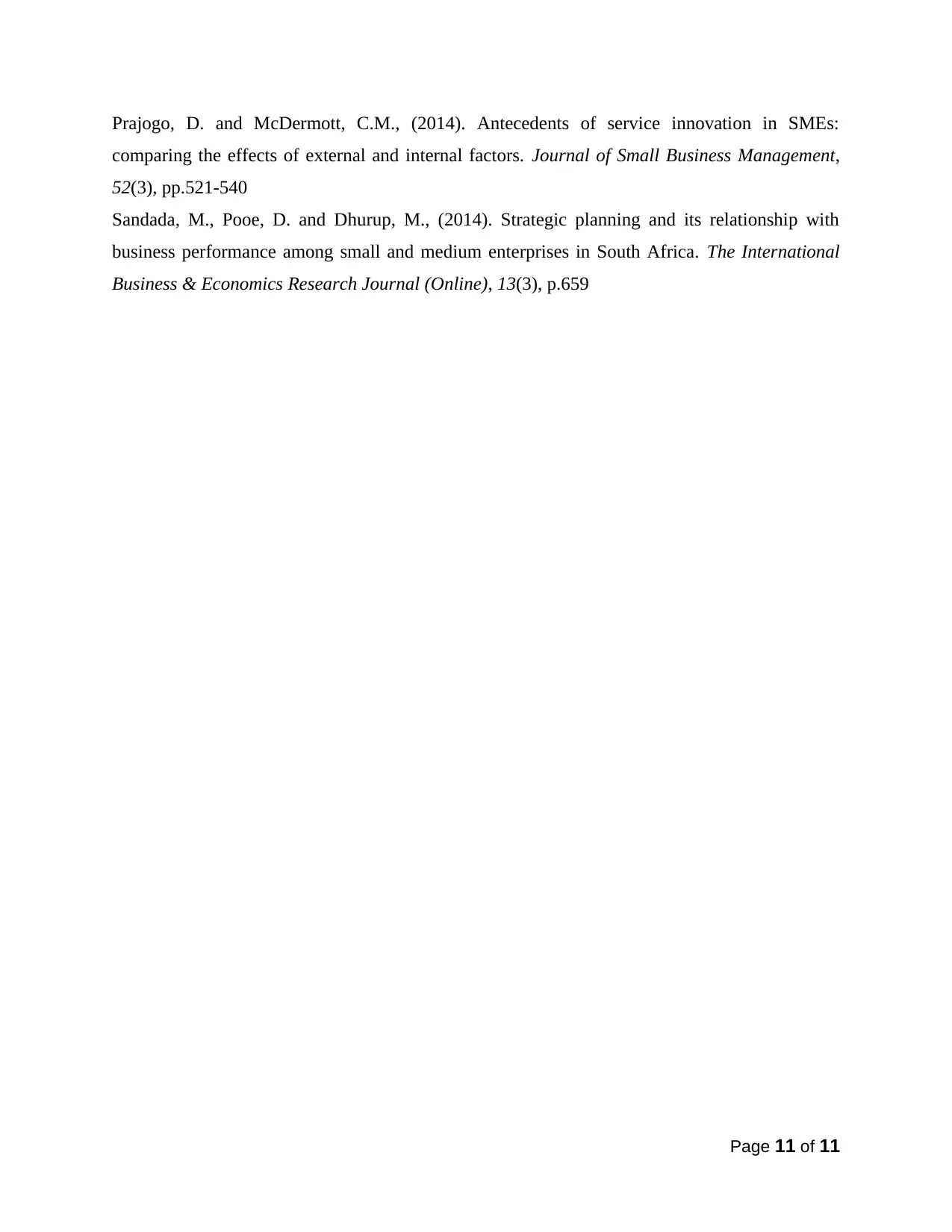
Prajogo, D. and McDermott, C.M., (2014). Antecedents of service innovation in SMEs:
comparing the effects of external and internal factors. Journal of Small Business Management,
52(3), pp.521-540
Sandada, M., Pooe, D. and Dhurup, M., (2014). Strategic planning and its relationship with
business performance among small and medium enterprises in South Africa. The International
Business & Economics Research Journal (Online), 13(3), p.659
Page 11 of 11
comparing the effects of external and internal factors. Journal of Small Business Management,
52(3), pp.521-540
Sandada, M., Pooe, D. and Dhurup, M., (2014). Strategic planning and its relationship with
business performance among small and medium enterprises in South Africa. The International
Business & Economics Research Journal (Online), 13(3), p.659
Page 11 of 11
1 out of 11
Related Documents
Your All-in-One AI-Powered Toolkit for Academic Success.
+13062052269
info@desklib.com
Available 24*7 on WhatsApp / Email
![[object Object]](/_next/static/media/star-bottom.7253800d.svg)
Unlock your academic potential
Copyright © 2020–2025 A2Z Services. All Rights Reserved. Developed and managed by ZUCOL.




